Are you a beginner birder looking to identify the most common birds you might come across? The birds on this list are species you are most likely to see in your backyard or a suburban park. Discover where the 12 types of the most common birds live, what they eat, how to attract them, and how to distinguish them.
Mourning Dove
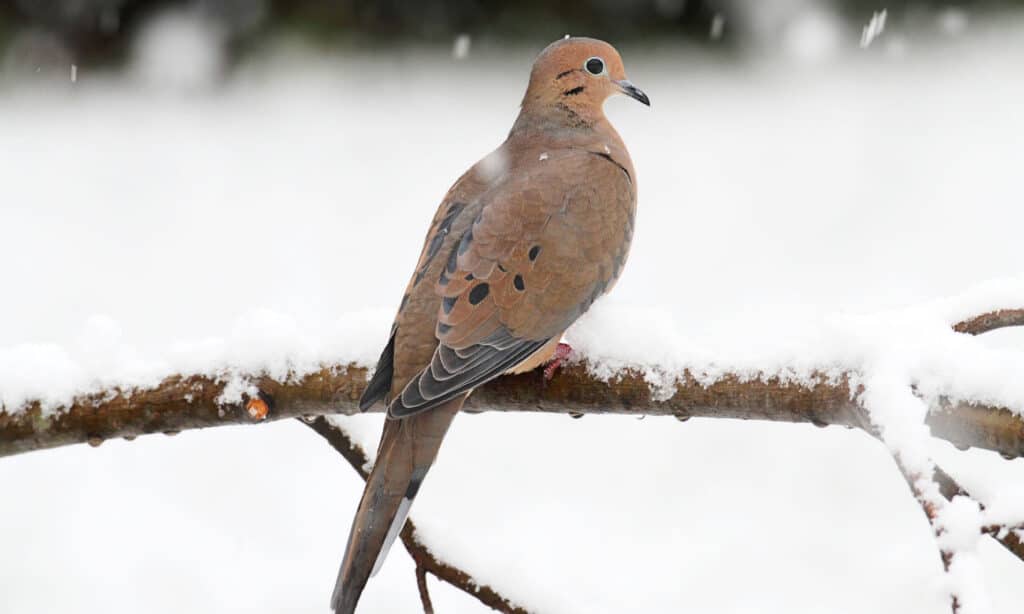
Mourning doves live year-round in the United States.
©iStock.com/SteveByland
Location and Habitat: Mourning doves live year-round throughout most of the United States, and populations that breed in southern Canada migrate to Mexico and Central America for the winter. These birds live in farms, towns, grasslands, and open woodlands.
Appearance: They have plump bodies with long necks and relatively small heads. Their plumage is a mix of gray, tan, and buff, with black spots and white tips.
Diet: 99% of their diet consists of seeds. They consume seeds from grains, grasses, ragweeds, and other plants.
Vocalizations: Mournful “coos” and loud whistling
Backyard Tip: Provide millet in a platform feeder or scatter seeds on the ground
Fun Fact: They eat up to 20 percent of their body weight daily.
American Goldfinch
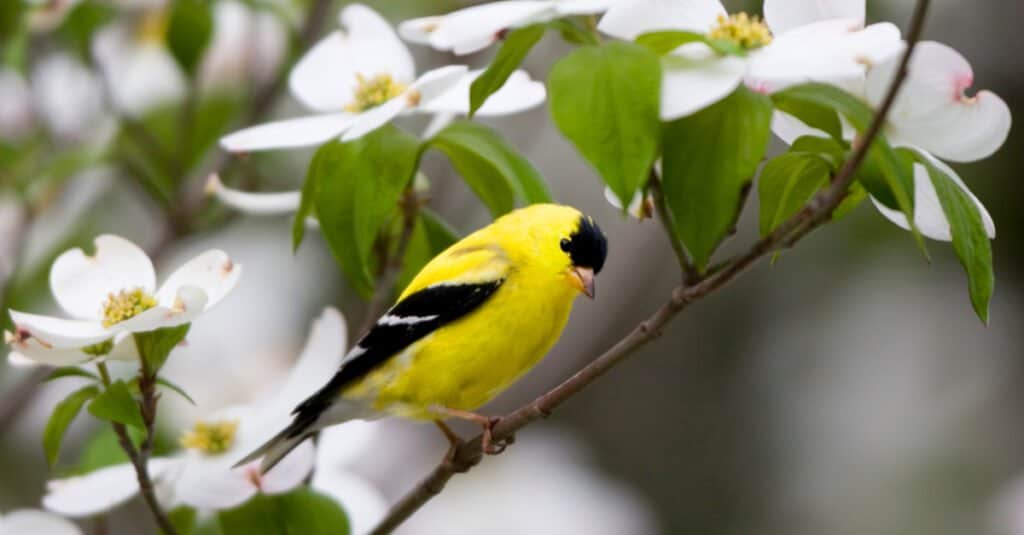
The male American goldfinch has brighter coloring in the summer to attract a mate.
©Danita Delimont/Shutterstock.com
Location and Habitat: These North American birds breed in southern Canada and winter in the southern US and Mexico. However, populations living in the northern United States live there year-round. You will often find them in thistles and weeds, along roadsides, and near open woods.
Appearance: These small finches have conical-shaped bills, long wings, and short tails. Adult males feature the most notable plumage, with bright yellow bodies and black caps, wings, and tails. Females are olive and pale yellow.
Diet: The goldfinch is a seed-eater, preferring seeds from grasses and trees.
Vocalizations: Bright “potato-chips” and long, variable warbles
Backyard Tip: Plant thistle and milkweed and provide sunflower seeds and nyger.
Fun Fact: They eat a strict vegetarian diet, rarely swallowing an insect.
American Robin
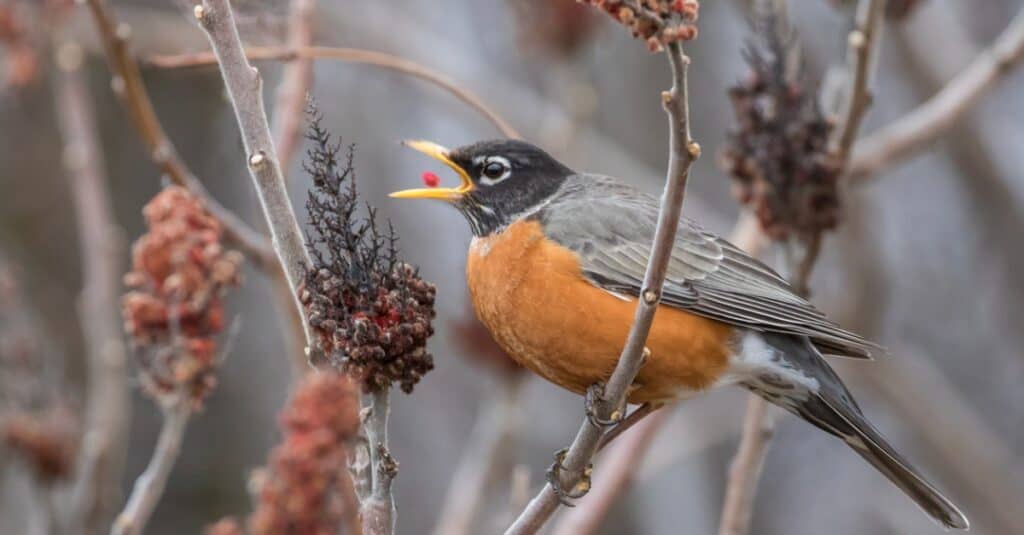
American robins eat fruit and invertebrates.
©iStock.com/mirceax
Location and Habitat: The American robin breeds throughout Alaska and Canada, lives year-round in the United States, and winters in Mexico. These birds are common around cities, towns, parks, and farms.
Appearance: These large songbirds have round bodies, long tails, and long legs. Their heads, backs, wings, and tails are grayish-brown, and their undersides are orange with a lower white belly patch. Females are pale gray with duller orange breasts.
Diet: They eat invertebrates, fruit, and occasionally small reptiles.
Vocalizations: Rich carols and mumbled “cucks”
Backyard Tip: Provide chopped fruit and mealworms
Fun Fact: Up to 250,000 robins can roost together at one time.
Northern Cardinal

The northern cardinal has a thick bill, a long tail, and a conspicuous crest.
©iStock.com/BeyondMyLens
Location and Habitat: Northern cardinals live year-round in the eastern half of the United States and Mexico. They live in thickets, gardens, towns, and woodland edges.
Appearance: These large birds feature long tails, thick bills, and conspicuous crests. Adult males are bright red with black faces, and females are brown with a red tinge.
Diet: They eat seeds, fruit, and insects.
Vocalizations: Slurred whistles, slow trills, and metallic chirps
Backyard Tip: Leave undergrowth in your yard and set out sunflower seeds
Fun Fact: Cardinals attack their reflection in windows and car mirrors.
American Crow
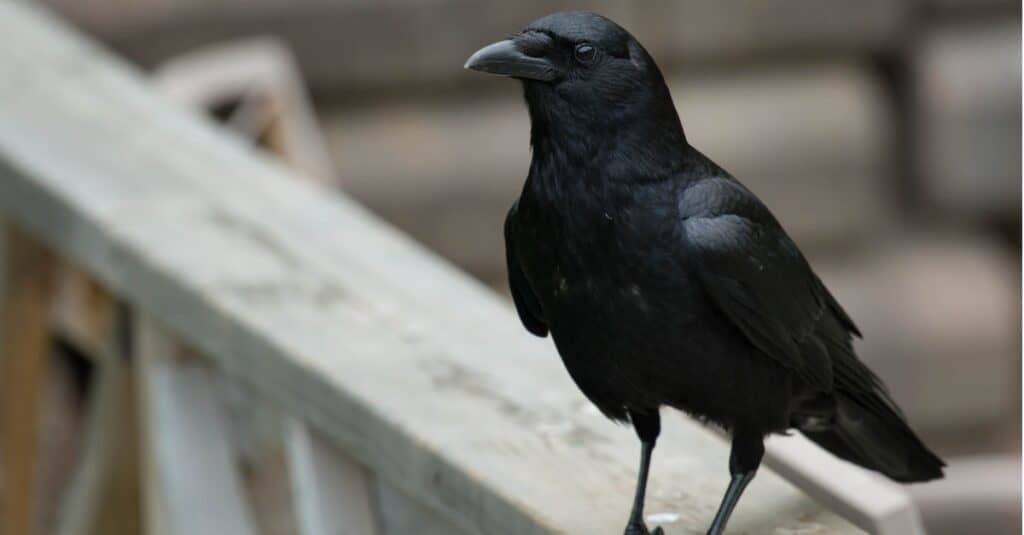
Crows live in woodlands, farms, towns, and cities.
©iStock.com/PaulReevesPhotography
Location and Habitat: Crows are common year-round in the United States. But you may only see them during spring and summer in Canada. These birds live in woodlands, farms, towns, fields, and groves.
Appearance: Crows are large, long-legged birds with thick necks and broad bills. They feature all-black plumage but can appear brown after molting.
Diet: The American crow has a wide-ranging diet, which includes insects, small animals, grains, seeds, fruits, and berries.
Vocalizations: Loud, harsh “caws”
Backyard Tip: They like open spaces, peanuts, and pet food.
Fun Fact: Some crow roosting sites are over 100 years old!
Blue Jay
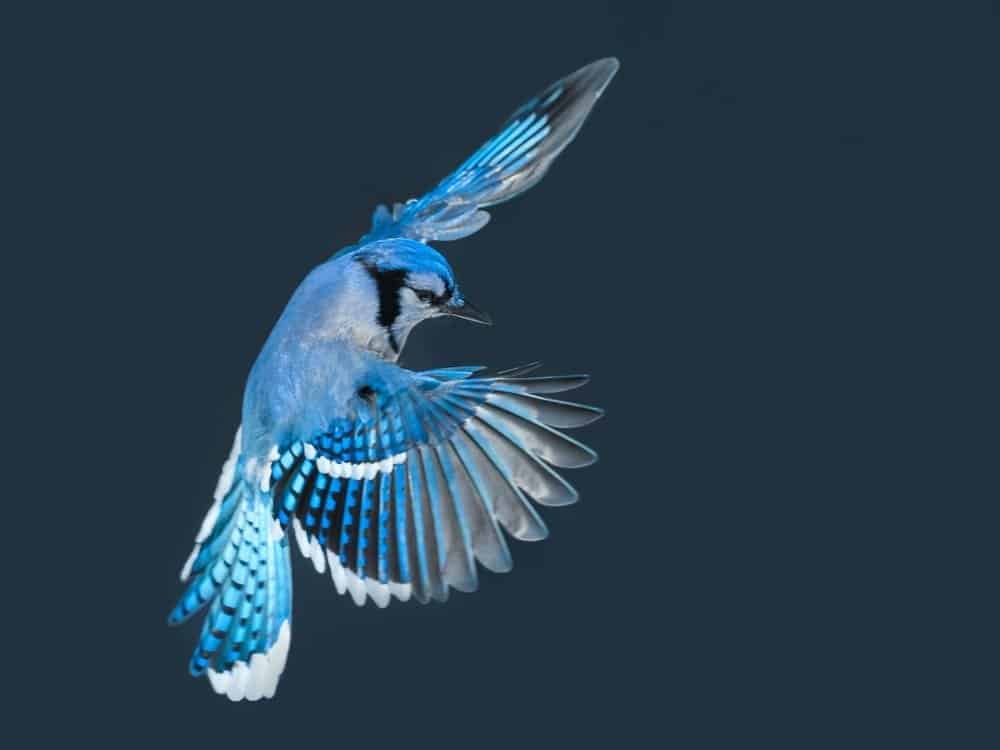
Blue jays are large songbirds with crests and long tails.
©FotoRequest/Shutterstock.com
Location and Habitat: Blue jays live year-round in the eastern half of the United States. But some populations migrate to the northwest during winter. Their primary habitats include woodlands, gardens, towns, and groves.
Appearance: Another large songbird with crests and long, rounded tails. Their plumage is grayish-white below and blue, black, and white above. Their faces also feature black markings.
Diet: They eat insects, small invertebrates, nuts, seeds, and grains.
Vocalizations: Harsh cries and soft clicks
Backyard Tip: Provide suet, sunflower seeds, or peanuts on a tray feeder
Fun Fact: They mimic the calls of red-shouldered hawks.
Song Sparrow
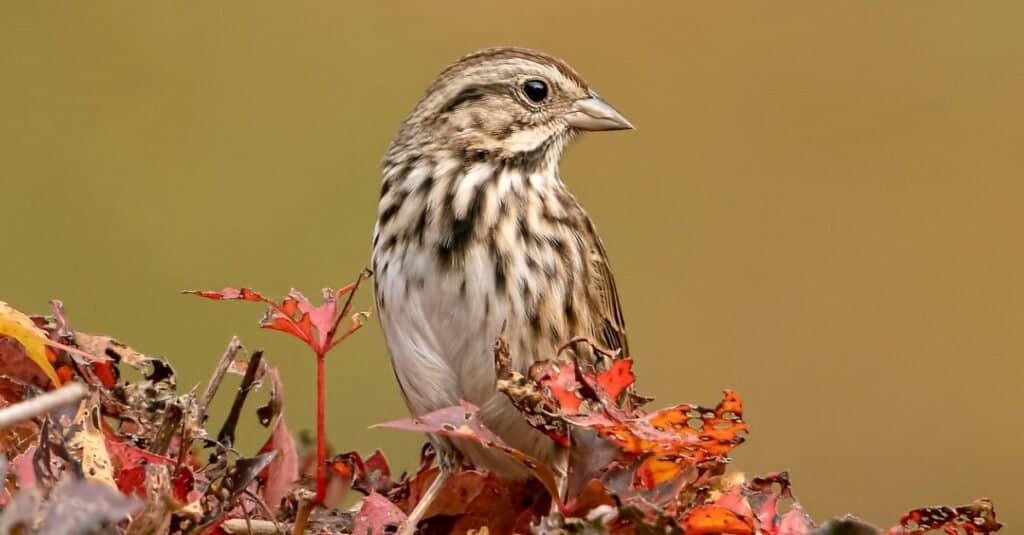
Song sparrows produce short notes and varied trills.
©iStock.com/Luc Pouliot
Location and Habitat: Some populations live year-round in northern portions of the United States and southwestern areas of Canada. But those that breed in central Canada migrate to the southern United States during winter. Their habitats include thickets, brush, marshes, gardens, and streamsides.
Appearance: These medium-sized birds have short bills, round heads, long tails, and broad wings. Their plumage is a mixture of reddish-brown and gray streaks with white breasts.
Diet: They eat insects, invertebrates, seeds, and fruits.
Vocalizations: short notes and varied trills
Backyard Tip: Plant berry bushes and provide a bird bath
Fun Fact: Song sparrows can lay up to seven clutches in one breeding season.
Downy Woodpecker
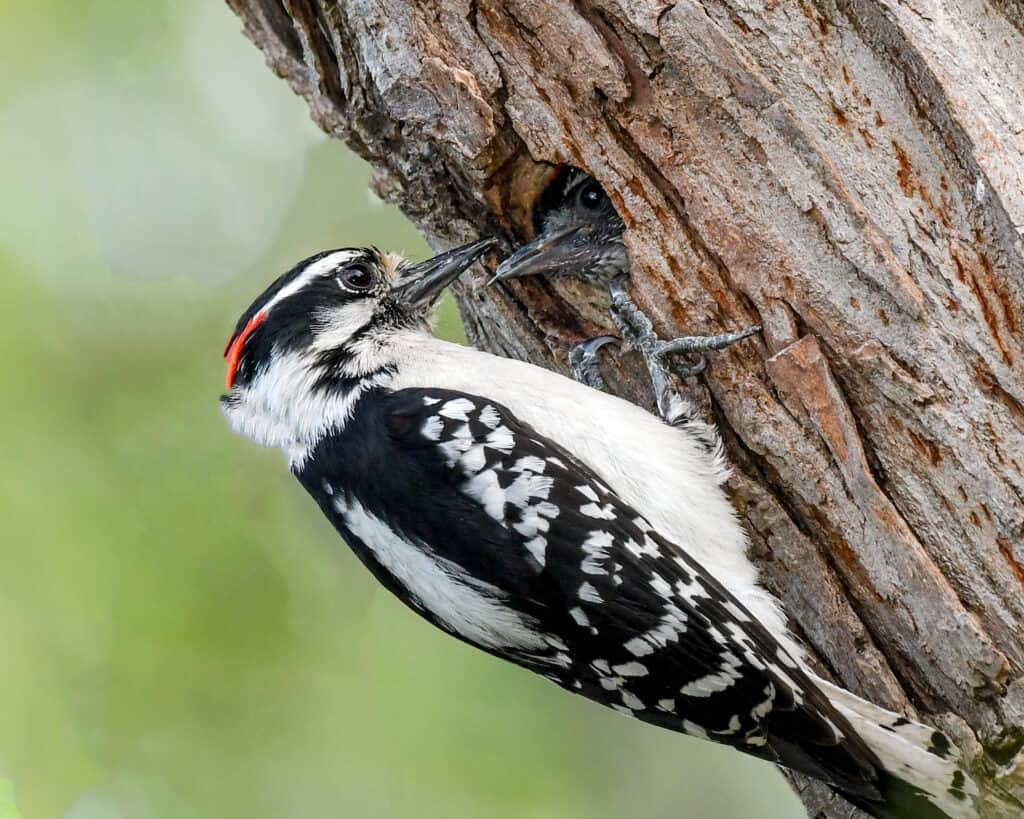
Downy woodpeckers inhabit forests, woodlots, orchards, and groves.
©Brent Barnes/Shutterstock.com
Location and Habitat: The downy woodpecker is permanent in its environment, living year-round throughout the United States and Canada. They inhabit forests, woodlots, orchards, and groves.
Appearance: Woodpeckers are small, straight-backed birds with straight bills and wide shoulders. These birds have black wings and tails, with white spots and a broad white stripe down the back. Their undersides are white and their faces have black markings and a bright red patch on their crown.
Diet: They eat pest insects, berries, acorns, and grains.
Vocalizations: Sharp “pik” notes and descending rattles
Backyard Tip: Provide hummingbird feeders and suet
Fun Fact: They forage in large mixed species flocks to better evade predators.
House Finch
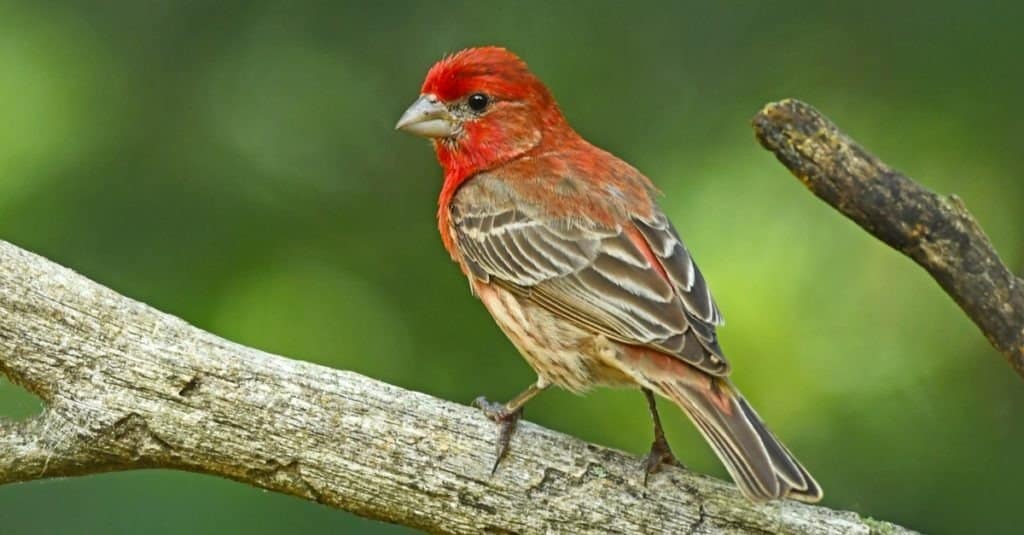
House finches live year-round in the United States and Mexico.
©Brian A Wolf/Shutterstock.com
Location and Habitat: The house finch lives permanently in Mexico and the United States. But this species is less abundant in the central portions of the US. Look for them in cities, farms, canyons, and suburbs.
Appearance: These small finches have large beaks and flat heads. Adult males possess rose-red faces and breasts, streaky brown upperparts, and whitish undersides. Females are grayish-brown with no red plumage.
Diet: They eat seeds, buds, berries, and small aphids.
Vocalizations: Chirp calls and canary-like warbles
Backyard Tip: Place black oil sunflower seeds in your backyard feeder
Fun Fact: Females look for males with the reddest plumage to mate with.
Red-Winged Blackbird

The red-winged blackbird has broad shoulders with red and yellow patches.
©iStock.com/Michael-Tatman
Location and Habitat: Most populations live year-round in the United States and Mexico. But those that breed in Canada migrate to the northern Mexican coast for winter. They live in marshes, swamps, weedy fields, and pastures.
Appearance: Red-winged blackbirds are stocky with thin bills and broad shoulders. The male plumage is unmistakable, featuring all-black feathers with distinct red and yellow shoulder patches. Females are streaky dark brown and lack bright coloring.
Diet: They eat insects, seeds, berries, and small fruits.
Vocalizations: Rich, musical trills
Backyard Tip: Spread mixed grains and seeds on the ground
Fun Fact: Males may have up to 15 mates during the breeding season.
European Starling
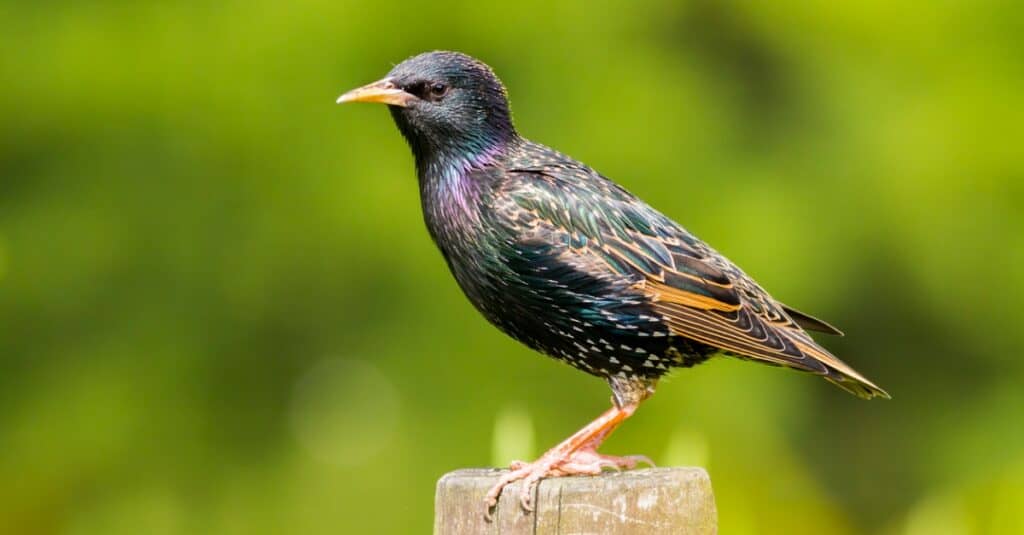
European starlings have glossy, iridescent feathers.
©iStock.com/chris2766
Location and Habitat: The European starling has an extensive range across the United States and Canada, where they live permanently. Populations also migrate to Mexico during winter. This species inhabits cities, parks, groves, fields, and farms.
Appearance: These chunky birds have short tails and long, pointed beaks. They feature black plumage with green and purple iridescence and yellow bills.
Diet: They eat insects, fruits, berries, seeds, and flower nectar.
Vocalizations: Squeaky musical notes and purr-like calls
Backyard Tip: Provide dry mealworm and suet balls
Fun Fact: The North American European starling population came from 100 birds that were released in New York during the 1800s.
Canada Goose
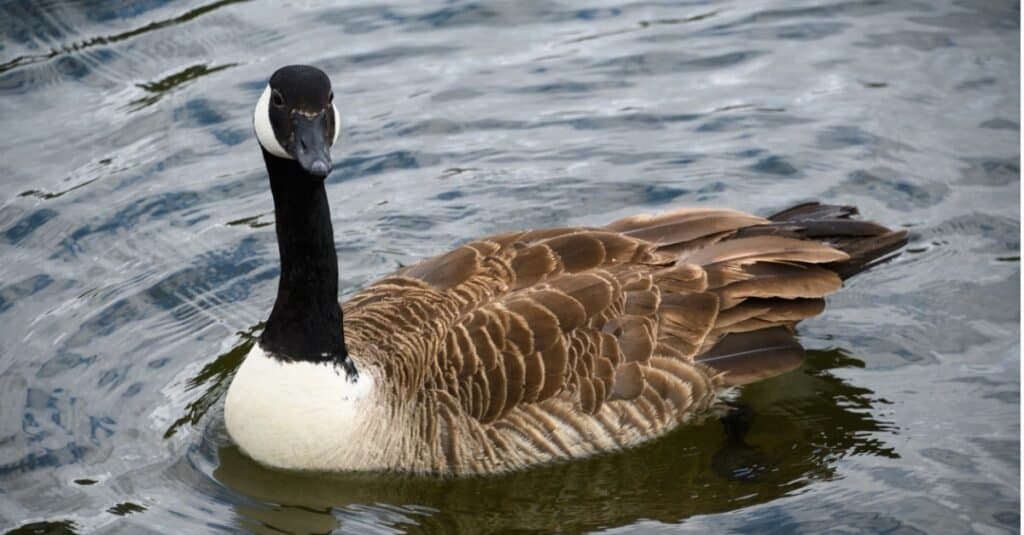
The Canada goose lives on lakes, ponds, marshes, and bays.
©Roger Utting/Shutterstock.com
Location and Habitat: Canada geese have a significant breeding range across Canada and they migrate to the southern United States for winter. There are also year-round populations in the temperate northern United States. Their preferred habitats include lakes, ponds, marshes, bays, and fields.
Appearance: These geese are large waterbirds with long necks, flat beaks, and webbed feet. They have brown bodies with black and white heads and necks.
Diet: They mainly eat plant material but may also consume insects, mollusks, small fish, and crustaceans.
Vocalizations: Loud honking, barking, and hissing
Backyard Tip: They will visit a property with mowed lawns that back up to the water’s edge.
Fun Fact: The oldest Canada goose lived to be 33 years old.
Up Next:
The photo featured at the top of this post is © Paul Reeves Photography/Shutterstock.com
Sources
- Wiley Online Library, Available here: https://onlinelibrary.wiley.com/doi/abs/10.1111/j.1558-5646.1993.tb02172.x
- IUCN RedList, Available here: https://www.iucnredlist.org/
Thank you for reading! Have some feedback for us? Contact the AZ Animals editorial team.






